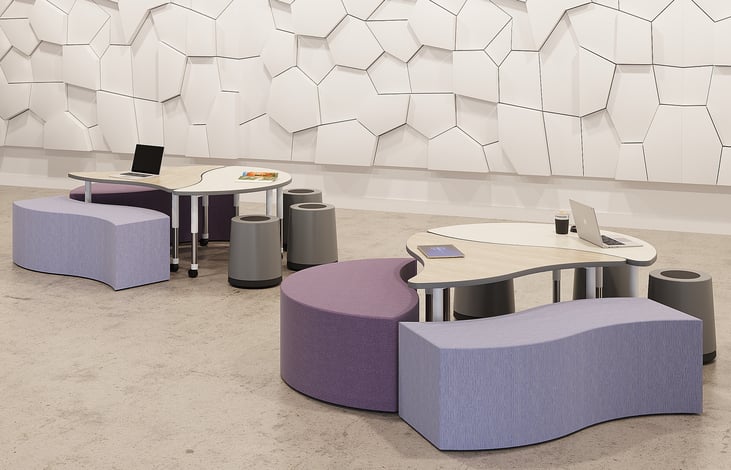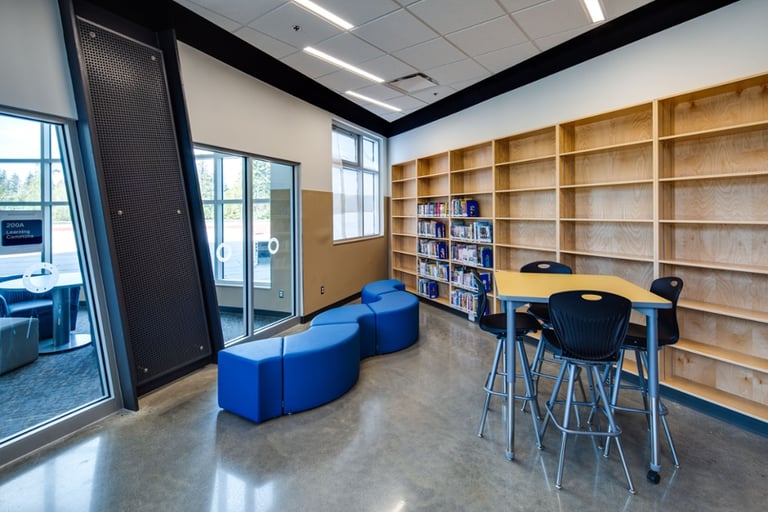Solutions: Breakout Spaces
building confidence through collaboration
Small group learning is great for building communication and social skills. Providing breakout spaces within or outside the classroom encourages students to gather so they can intuitively problem solve, debate, create and learn.
As you design your breakout spaces, think about how each will function, how it supports the student learning outcomes and how it makes students feel. For questions to guide your discussion: Download the planning guide.

the power of breakout spaces: enhancing learning environments
-
-
-
- Encouraging Collaboration: Breakout spaces let students work in small groups, promoting collaboration and teamwork. In traditional classrooms, students often get limited interaction with their peers due to space constraints. Small breakout spaces provide a more intimate and relaxed setting for open discussions and brainstorming sessions. By actively engaging with their peers, students develop essential interpersonal skills, such as effective communication, negotiation, and problem-solving abilities.
-
Facilitating Active Learning: Active learning is an instructional approach that encourages students to participate actively in the learning process. Breakout spaces lend themselves to active learning, providing a dynamic environment for hands-on activities, group projects, and experiential learning. These spaces can be equipped with interactive technology, flexible furniture, and resources tailored to specific subjects or projects. By engaging in active learning experiences within breakout spaces, students become active contributors to their own education, fostering a deeper understanding of the subject matter.
-
Supporting Different Learning Styles: Every student has unique learning preferences and styles. While some learners thrive in a traditional lecture-based environment, others may require more interactive and immersive experiences. Breakout spaces cater to diverse learning styles by offering flexible learning environments. These spaces can be customized to accommodate various learning activities, such as small group discussions, research projects, presentations, or creative workshops. By providing options, breakout spaces allow students to select the environment that best suits their individual needs, thereby enhancing their overall learning experience.
-
Promoting Creativity and Innovation: Creativity and innovation are crucial skills for the 21st-century workforce. Breakout spaces provide students with the freedom to explore ideas, experiment with new concepts, and think outside the box. These areas can be designed to inspire creativity, incorporating elements such as whiteboards, brainstorming walls, art supplies, and comfortable seating arrangements. By fostering an environment that encourages innovation, breakout spaces help students develop their problem-solving abilities, boost their confidence, and nurture their entrepreneurial mindset.
-
Reducing Distractions: In a traditional classroom setting, distractions can often hinder students' focus and concentration. Breakout spaces offer a dedicated space away from the main classroom, minimizing potential disruptions. By providing a quieter and more controlled environment, breakout spaces enable students to concentrate on their tasks, engage in deep thinking, and enhance their overall productivity.
-
-

helpful links
- Case Study: Georgetown, TX
- Learning Environments That Promote Safety + Security
- Develop Social + Interpersonal Skills with these Classroom Setup Ideas
- Color Inspiration Guide
- Planning Typicals
EXPLORE breakout spaces: SLIDE SHOw
Click through various flexible learning environments below or visit our image gallery of breakout spaces designed to promote creativity and innovation.

A PLACE TO GATHER
Whether you're a student or a teacher, it's important to have a learning environment that is comfortable and welcoming. When you feel at ease in your surroundings, you're more likely to be engaged, focused, and creative.
Create comfortable learning spaces by providing flexible seating options, like curved benches and round rockers.

CORNER CAFE
Whether your students are reading, working on a project, or just taking a break, a classroom café can help them feel more relaxed and engaged. And who knows? They might even discover a new favorite book or make a new friend!

GATHERING SPOT
Use any open space to create a gathering spot. Using soft seating, you can build a flexible space for impromptu meetings and socializing that can also double as a project planning space for small groups.

EXPLORE ON YOUR OWN
Maker space labs allow a small group of students to explore outside of typical classroom work. A sturdy maker space table and ample storage for supplies are all you need.

DISTANCE LEARNING OR TELECON MEETING?
Create small spaces where students or staff can meet and collaborate. A table and some comfortable chairs are all that's required.

COLLABORATION + CREATIVITY IN ANY WORKSPACE
Whether you need a change of scenery for a virtual class or a productive space for a remote team meeting, this breakout space with technology and lounge seating is the ultimate solution to boost productivity and foster a sense of community among colleagues.

QUIET RETREAT
Small group learning environments provide students space to demonstrate mastery by creating and presenting projects that simulate real research methods.

"HUDDLE" ROOMS
provide students or staff a place to meet over projects or allow privacy for assessment testing. A few desks and comfortable soft seating that can be reconfigured lends to the relaxed, low-stress environment.

WORK ON PROJECTS
Create a project space in a media center where students can spend time working on presentations and art projects. Versatile 3P-120 Shape Table works for 3 students with proper social distancing now and more later. Round Rockers and Arcs provide a fun seating option.

WALK UP WORK
A standing racetrack café table in a breakout room gives students a chance to change positions while working on projects.

MIX UP HEIGHTS
Movement is important to increase respiration and blood flow. Use floor seating and reduced height work surfaces to encourage floor work.

USE EXTRA SPACE
Creative use of furniture can help teachers maximize learning. Standing height desks paired with café stools allow students a space to learn that meets their needs.

BREAKOUT ANYWHERE
Imagine a breakout space that combines the best of technology and comfort with lounge seating. This innovative space is equipped with state-of-the-art technology, including interactive touchscreens and video conferencing capabilities, making it perfect for distance learning or telecon meetings.
preparing students for success
Learning can happen anywhere and anytime. Having the right furniture sets the stage for that learning. Breakout spaces offer numerous benefits, including encouraging collaboration, facilitating active learning, supporting different learning styles, promoting creativity and innovation, and reducing distractions. By providing flexible and comfortable furniture options, such as curved benches, soft seating, and reconfigurable tables, educational institutions can empower students to actively participate in their education, develop essential skills, and unleash their creative potential. So, whether it's a classroom café, a gathering spot, a quiet retreat, or a breakout room equipped with state-of-the-art technology, incorporating breakout spaces into learning environments is a significant step forward in preparing students for success in the modern world. To explore more about designing effective breakout spaces and further enhance the learning experience, download the planning guide and explore the various flexible learning environments provided.
Recent Posts
In part one of our series on thoughtful classroom design, we heard an educator’s perspective on...
In part one of our series on thoughtful classroom design, we heard an educator’s perspective on...



